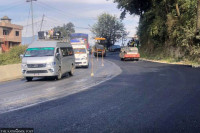National
Nepal and China still haven’t notified each other on readiness to implement the transit deal
The Transit and Transportation Agreement, which will give Nepal access to seven Chinese land and sea ports, will only come into effect once both sides officially notify each other..jpg&w=900&height=601)
Anil Giri
Three months since the signing of the Protocol to the Agreement on Transit and Transportation, Nepal and China have yet to notify each other that they are ready to implement the pact, which will allow Nepal access to four Chinese seaports—Tianjin, Shenzhen, Lianyungang and Zhanjiang—and three land ports—in Lanzhou, Lhasa and Shigatse—for third-country imports.
Immediately after signing the protocol during President Bidya Devi Bhandari’s visit to China in April, both China and Nepal had said the protocol would come into effect immediately and that Chinese sea and land ports would be ready to use for Nepali traders. However, Nepal and China must inform each other officially that their internal laws and regulations are in place to allow transit and transportation, before any actual work can begin. Neither side has done so.
“We are collecting feedback and logistical status from all concerned line ministries and will soon notify the Chinese side that all our preparations regarding the protocol are ready,” said Kedar Bahadur Adhikari, secretary at the Ministry of Industry, Commerce and Supplies.
The ministry has written to other line ministries—Ministries of Agriculture, Law and Justice, Physical Planning and Infrastructure—asking whether they were prepared to execute the protocol with China, but it has yet to hear back from everyone, said Adhikari.
Earlier in July, the delay in implementing the protocol had led Industry Minister Matrika Prasad Yadav to ask officials to complete their preparations and notify the Chinese as soon as possible. But even Yadav’s instructions came a little too late.
“As soon as we reached an agreement with the Chinese, we should’ve called a meeting of all line ministries and communicated to the Chinese side that we are ready to implement the protocol. That never happened,” said former joint secretary Rabi Shankar Sainju, who was instrumental in holding negotiations with the Chinese over the protocol text.
There are numerous reasons behind the delay, which include a delay in writing to the Chinese seeking its approval for a field visit, getting logistics ready on our side, a lack of homework on various fronts like quarantine, customs and setting up new infrastructure on the Nepal side.
Article 15 of the Protocol to the Agreement on Transit and Transportation states that the protocol will come into effect only a month after both sides officially notify each other.
The agreement also says a technical team from Nepal would visit the Chinese land and seaports to ascertain their modus operandi. But that team too has yet to be dispatched.
“We have sent a request to the Chinese to assist the Nepali technical team, which will visit various Chinese sea and land ports, but we have yet to receive a confirmation,” said Adhikari.
However, the Chinese side has not notified Nepal that its preparations and internal procedures are complete either. But since the Transit and Transportation Agreement is important for Nepal, it should be the first to call on the Chinese, said officials.
Attempts to reach the Chinese Embassy spokesperson by telephone and text message were unsuccessful.
In the wake of the Indian blockade in 2015, Prime Minister KP Sharma Oli had signed the Transit and Transportation Agreement with China in 2016, during his visit to Beijing. It had taken two more years for both sides to agree on the text of the protocol, which was finalised in September 2018. The protocol, a necessary prerequisite to implementation, was signed in April.
While the agreement was touted as a landmark achievement, as it ended Nepal’s long dependency on India and opened up new avenues for third-country trade via Chinese seaports, the freight forwarding community is doubtful of an immediate benefit to Nepali traders and the business community.
“We have yet to complete protocol regulations that will ensure logistics and the mode of transportation. Since the sea and land ports we have access to are now fixed, we have lost access to China’s vast opportunities and options,” Rajan Sharma, a former president of the Nepal Freight Forwarders’ Association, told the Post. “Most importantly, it is not going to be as great a benefit for third country trading when compared with Indian ports.”
“I also sense a lot of weakness on the part of our business support organisations like the FNCCI, Nepal Chamber of Commerce, and Confederation of Nepalese Industries. Have they done any research, logistical analysis or cost-benefit analysis? I don’t think so,” said Sharma.
Nepal also desperately needs to upgrade its infrastructure at the transit points, say officials.
“Nepal and China are currently conducting trade only from the Tatopani and Rasuwaghadi trade points,” said Sainju. “But Nepal and China have agreed to carry out trade through six dedicated transit points between Nepal and China—Rasuwa, Kodari, Kimathanka, Nechung, Yari and Olangchung Gola—where infrastructure is poor on the Nepal side. If Nepal wants to fully exploit Chinese sea and land routes, it needs to focus on building infrastructure.”
***
What do you think?
Dear reader, we’d like to hear from you. We regularly publish letters to the editor on contemporary issues or direct responses to something the Post has recently published. Please send your letters to [email protected] with "Letter to the Editor" in the subject line. Please include your name, location, and a contact address so one of our editors can reach out to you.




 16.57°C Kathmandu
16.57°C Kathmandu









%20(1).jpg&w=300&height=200)





